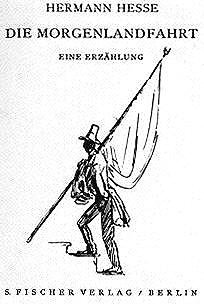Hermann Hesse "Die Morgenlandfahrt" 1932 / Герман Гессе "Паломництво до країни Сходу" 1932

The second day postponed the writing of this message, due to the lack of a clear idea of what I think of the book. Still, I dared to start, hoping that awareness will come during the process itself. Given the volume of the book, it would be more appropriate to see it as a novel rather than a roman. Although, the descriptions on different nationalities of Wikipedia pages do not match.
Probably, it is worth starting with the fact that this story was written back in 1932, or rather published this year. It is difficult to say in what style this work is written. It is even harder to say what the author was trying to convey to the reader. I have an opinion that only the author, and I'm not sure, 100% imagined about he wrote in this story.
The book traces hints of Freemasonry as a mysterious order and an incomprehensible, either sarcastic or philosophical image of the protagonist GG. although some claim that under these initials is the artist Gusto Greser, who participated in the "crusade of the child."
In the image of Leo (one of the main characters of the book), I generally imagine a kind of embodiment of one of the images of the personality of G.G. In this case, the image of the protagonist GG can be perceived as an image of a mentally ill person suffering from a split personality (depersonalization of personality). Although, this can only be my professionally distorted perception.
Regarding the content of the book, Hermann Hesse aptly stated in his letter to Alice Leotold:
"The symbolism of such a book does not need to be understood by the reader; it is necessary that he allow her paintings to penetrate. The effect must be in the subconscious."
Probably, this is the first book where I can safely tell about the plot because it will not be able to change the impression of the book, which gives much more questions after listening to it than answers.
Другий день відкладав написання цього повідомлення, через відсутність чіткого уявлення, що ж я думаю про книгу. Все ж таки наважився почати, з надією на те, що усвідомлення прийде вже підчас самого процесу. Враховуючи об’єм книги її буде більш доречно сприймати як повість, а не як роман. Хоча, описи на різних за національністю сторінках вікіпедії не співпадають.
Напевно, варто почати з того, що ця повість написана в далекому 1932 році, точніше опублікована в цьому році. Важко сказати, в якому стилі написана ця праця. Ще важче сказати, що намагався донести до читача автор. В мене склалась думка, що тільки автор, і то я в цьому не впевнений, на 100% уявляв про що він написав цю повість.
В книзі прослідковуються натяки на масонство, як таємничий орден та, незрозумілий, чи то саркастичний, чи то філософський образ головного героя Г. Г. С приводу головного героя також не все так просто, в ініціалах Г. Г. можна одночасно прослідкувати ініціали автора, хоча деякі стверджують, що під цими ініціалами художник Густо Грезера, що брав участь у «хрестовому поході діте».
В образі Лео (одного з головних героїв книги), мені взагалі уявляється своєрідне втілення одного з образів особистості Г.Г. В такому разі, в образі головного героя Г. Г. можна сприйняти образ психічно хворої людини, що страждає на роздвоєння особистості (деперсоналізацію особистості). Хоча, це може бути лише моє професійно деформоване сприйняття.
З приводу змісту книги Герман Гессе влучно висловився в своєму листі до Аліси Лйотольд:
«Символіка такої книги не потребує того, щоб бути зрозумілою читачем; потрібно, щоб він дозволив її картинам проникнути в себе. Ефект повинен складатися в підсвідомому сприйнятті.»
Напевно, це перша книга де я можу сміливо розповідати про сюжет, адже це ну ніяк не зможе змінити враження від книги, що дарує значно більше питань після її прослуховування ніж відповідей.
My referals link
Exchanges
Binance | Poloniex | Huobi | Cryptex24 | Ionomi
Cryptogames
Oceanplanet | c24 games | Splinterlands | Cryptobrewmaster | Exodegame | Rabona
Cryptoblogs


https://twitter.com/Andruto2/status/1351832122370224128
Congratulations @cranium! You have completed the following achievement on the Hive blockchain and have been rewarded with new badge(s) :
You can view your badges on your board and compare yourself to others in the Ranking
If you no longer want to receive notifications, reply to this comment with the word
STOPI have read some of Herman Hesse book but never this one. I didn't quite finish Stepenwolf but I enjoyed reading half of it. Perhaps I can pick that book again in the future. By that description, this book seems to be catching my personal interest; Freemasonry is the trigger word. So, I'll have to check what is this book about.
~ Mac
You will not regret it, the book is very accessible and has a deep meaning.
Hi cranium,
Visit curiehive.com or join the Curie Discord community to learn more.
Thank you!!!